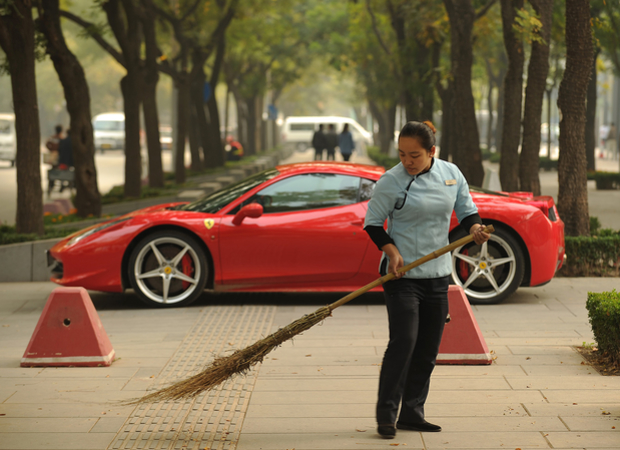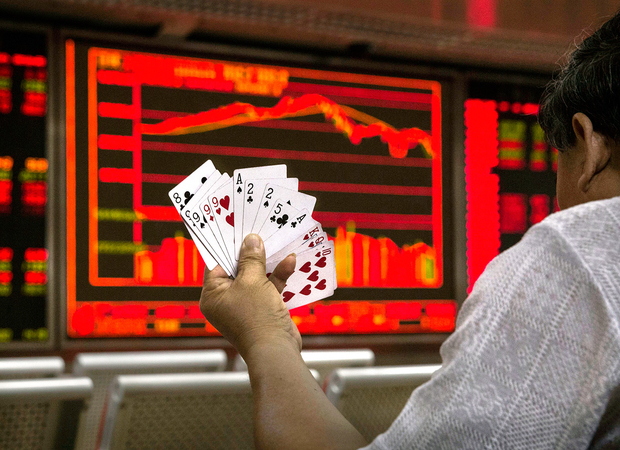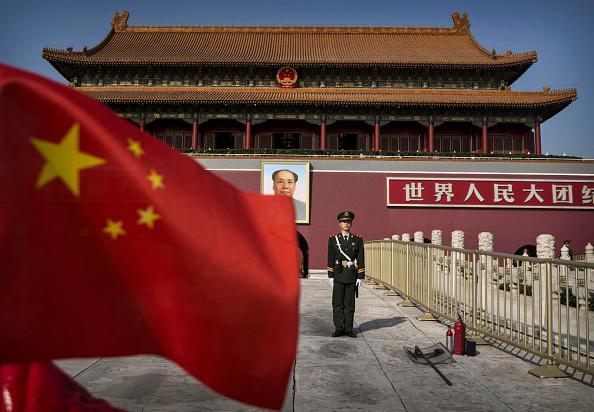On August 12, the International Monetary Fund (IMF) issued its annual report card on China’s economy and gave the country mixed grades, finding that its “economic transition will continue to be complex, challenging, and potentially bumpy.” In particular, the report emphasized the need for China to get its corporate debt under control. That sounds sensible enough. But it does not reflect a consensus among or within the China-watching community. In fact, Western China analysts are caught up in such a long-running debate about China’s trajectory that even a weighty conclusion like the IMF’s is unlikely to change their views at all.
The conflict over China’s trajectory pits three camps against each other: optimists, debt hawks, and policy critics. Their disagreements turn on their varying confidence in the Chinese government’s ability to manage the economy and alternative assessments about the threat that rising debt levels pose to the economy.
Conversation
05.24.16
How Much Debt Is Too Much in China?
Those outside the China-watching community often ascribe these competing conclusions to the opacity of China’s system—the assumption being that it leads to limited and perhaps differing sources of information for analysts, who become like the proverbial blind men touching different parts of an elephant. In fact, China analysts are awash in more data than ever before. China’s official statistics system has improved substantially, and there are alternative sources of information that allow for triangulation. As a result, the stark differences that continue to persist are primarily the result of competing assumptions and analytical frameworks.
Alas, although observers of China’s economy in any given camp occasionally critique the other, they rarely engage in extended head-on arguments. Their debate is instead akin to art critics looking at a landscape painting, with some focused on the rivers, others on the mountains, and still others on the sky. They may nitpick at the brush strokes of other parts of the painting or even admit to their limited beauty, but they generally don’t avert their eyes from what they have decided is most important.
The Good
There is not a single analyst that does not recognize both how far China has come and the monumental challenges it still faces. No country has grown as fast for as long. Yet the old sources of growth—an expanding, well educated workforce; extensive investment in industry; and exports—can no longer be sustained or generate the returns they once did. China can’t just pump out more stuff, or make even shinier hi-tech products; it needs to produce at a much more efficient clip and raise domestic consumption.
It’s not only Chinese officials and Chinese think tanks who believe the country can pull it off. Some veteran independent and highly respected analysts believe that the key to relatively high-speed growth lies in restructuring the economy, from investment toward consumption, from industry toward services, and within industry, from low-value-added assembly and manufacturing to high-value-added advanced manufacturing and innovation. They highlight all of the current policies geared to promote this transformation, including reducing overcapacity, encouraging movement into high-tech sectors and greater innovation, promoting household consumption (for example, by encouraging greater mortgage lending), and developing green technologies. And they point to data on the rapid expansion of services and consumption indicating that progress is well underway. To this camp, everything else—stock market volatility, foreign exchange outflows, trade disputes, and elite political intrigue—are all just noise distracting observers from what really matters.
The Bad
This optimism resembles naiveté to those who focus on an entirely different set of data points: China’s massive debt. Chinese red ink has grown far more rapidly than its economy. Even official data place total debt at around 250 percent of GDP, while some independent estimates put the figure at over 300 percent. Credit is still expanding quickly, and a disproportionate amount is still funneled to state-owned enterprises (SOEs). It’s not just that corporate debt is astronomical, with state-owned banks continuing to funnel cash to SOEs to stay afloat. It’s that the underreporting of bad debt (by rolling over loans and bonds and moving debt off balance sheets), the ambiguity of local government finances, the spread of sketchy wealth management products, and the emergence of online financing all mean that the true extent of leverage is sketchy and that official data on bad loans—under 2 percent—is likely a gross understatement of systemic risk.
The debt hawk camp gained additional adherents in 2015 and early 2016 as a result of serious gyrations in both China’s stock market and the value of its currency, the renminbi, partly due to the backfiring of ill-advised “circuit breaker” policies that actually sent China’s bourses and foreign exchange reserves reeling. Although the volatility has subsided, debt hawks believe China is enjoying only a superficial calm and has, in fact, passed the point of no return. One adherent of this position recently asked: “How much Chinese debt is too much? The amount that helps prevent painful reforms? In this light, there is already too much.”
Media
05.12.16
The End of China’s Economic Miracle? A Discussion with ‘Financial Times’ Writers
Debt has grown so much so quickly that people in this camp believe there is essentially little the government can do to stave off the day of reckoning. China is most likely either to suffer a financial crisis or descend into a long-term anemic growth stupor, much like Japan, albeit at a lower level of development and more unequal distribution of income. After all, countries with similar levels of debt have rarely avoided a financial crisis, and according to one observer, similar efforts taken at this late stage to restructure or stimulate the economy have all failed to reduce the debt burden and ward off a hard landing. To pessimists, a massive bailout and hard budget constraints on borrowers and lenders going forward is the only way to address the problem; but as they know, that is a step the Chinese government has been unwilling to take.
The Ugly
The final camp is convinced the current Chinese leadership has chalked up a long and growing list of policy mistakes. Some of these mistakes are not economic on their face, but in aggregate they have left China’s economy far short of its potential. Unlike debt hawks, policy critics think there’s still time to save it.
According to policy critics, while China has long intervened in the economy, the greater centralization of authority under Xi Jinping, including his signature anti-corruption campaign, has affected the extent, duration, and effect of this intervention. It has meant the quieting of alternative viewpoints in the national bureaucracy and local governments, giving potentially liberal advocates less of a voice when policies are being drafted. There are fewer bottom-up initiatives, and the leadership has a shorter learning curve when policies run into difficulty during implementation because the political atmosphere has clogged feedback loops. Then of course, there’s the bungled management of the stock market, the ambiguous adjustments to the exchange rate regime, the timidity of SOE governance, a new five-year plan that stresses massive state support for a wide range of advanced technologies, and dozens of other policy initiatives which all leave the clear impression that strengthening “China, Inc.” is a higher priority than nurturing a more efficient market economy.
Policy critics agree with optimists that China still has enormous growth potential, but they disagree that restructuring is sufficient or that current measures add up to a genuine commitment to market reforms.
Critics of expanded intervention disagree with debt hawks in four ways. First, they place as much blame for economic slowdown on Xi’s policies as they do on China’s debt overhang. Second, whereas debt hawks believe the die has already been cast and that debt is invariably bringing the economy to its knees, policy critics believe China’s leaders could still resuscitate the economy if they would only adopt liberalizing reforms. Third, policy critics view a meltdown as relatively unlikely because of China’s growth potential and the economic and political tools China has to ward off a crisis, including massive savings deposits and the ability to open or close China’s capital accounts and banks at will. And finally, although they believe a financial crisis or hard landing is possible, policy critics also envision an alternative scenario of relatively high but volatile growth, in which the economy remains inefficient but in which investments supported by subsidized state funding help China move forcefully into high tech sectors. In such a scenario, China would maintain its current growth and governance model, with most of the costs being borne by other countries in the form of lost market share, price volatility, and macroeconomic shocks.
* * *
Which of the three lenses through which one chooses to view China can affect conclusions on a remarkable variety of issues, from China’s “supply-side” reforms to reduce overcapacity in infrastructure to intensive efforts to build capabilities in high-tech sectors such as semiconductors to China’s foreign economic policy.
Take, for example, China’s signature One Belt One Road (OBOR) initiative to build trade and investment ties over land and sea linking China to the rest of Asia, Europe, and Africa. Optimists view the plan as integral to helping China shed low-value-added and polluting industries, move up the value chain, and expand healthy trade and investment ties. By contrast, debt hawks are concerned that OBOR is motivated more by political vanity than market logic. To them, the result is likely to be billions in wasted investments, with China’s “ghost cities” being joined by “ghost countries” to China’s west, littered with empty buildings and unused highways. Finally, policy hawks worry that without sufficient buy-in from market actors, OBOR is actually serving as a disincentive to the central and local governments to liberalize China’s economy by giving a lifeline to politically connected financial institutions and companies that ought to be shuttered or forced to move into more profitable businesses.
As the G20 leaders prepare to meet in the prosperous Chinese city of Hangzhou in early September, now is a particularly good time for the three camps to compare notes and see if they might adopt a common posture. If optimists are right, the international community should be patient and give Xi the time and space that he needs to carry out a complicated reform agenda that must overcome special interests and other domestic opponents. But if debt hawks are right, the most appropriate response would be to press for debt restructuring and marketization of China’s financial system while at the same time insulating global financial markets from the potential spillover effects of a Chinese economy heading toward a crisis or extended recession.
On the other hand, if policy critics are correct—and the main story is China’s mistaken commitment to interventionism—then patience is no longer a virtue, and every manner of carrot and stick should be used to move China back toward a genuinely reformist path. For example, G20 members could insist that China’ massive supply in infrastructure-related sectors is China’s own fault caused by wasteful spending and not a “global problem” partly caused by low demand abroad. Countries could bolster their fair trade laws to reduce the damage from China exporting that excess capacity. And the Trans-Pacific Partnership (TPP), they would argue, should be ratified and bilateral investment treaties negotiated with China in part because they can serve as tools to incentivize China to liberalize its economy in a way that not only benefits its trading partners but also raises its own productivity.
In other words, the signals that China analysts are sending to policymakers are conflicted, and sometimes contradictory. One can only hope that China analysts from the opposing camps will step up their dialogue to hash out differences and set clearer yardsticks by which to judge China’s economic performance. It’s time to look at the rivers, the mountain, and the sky all at once. The stakes are too high to continue talking past one another.




